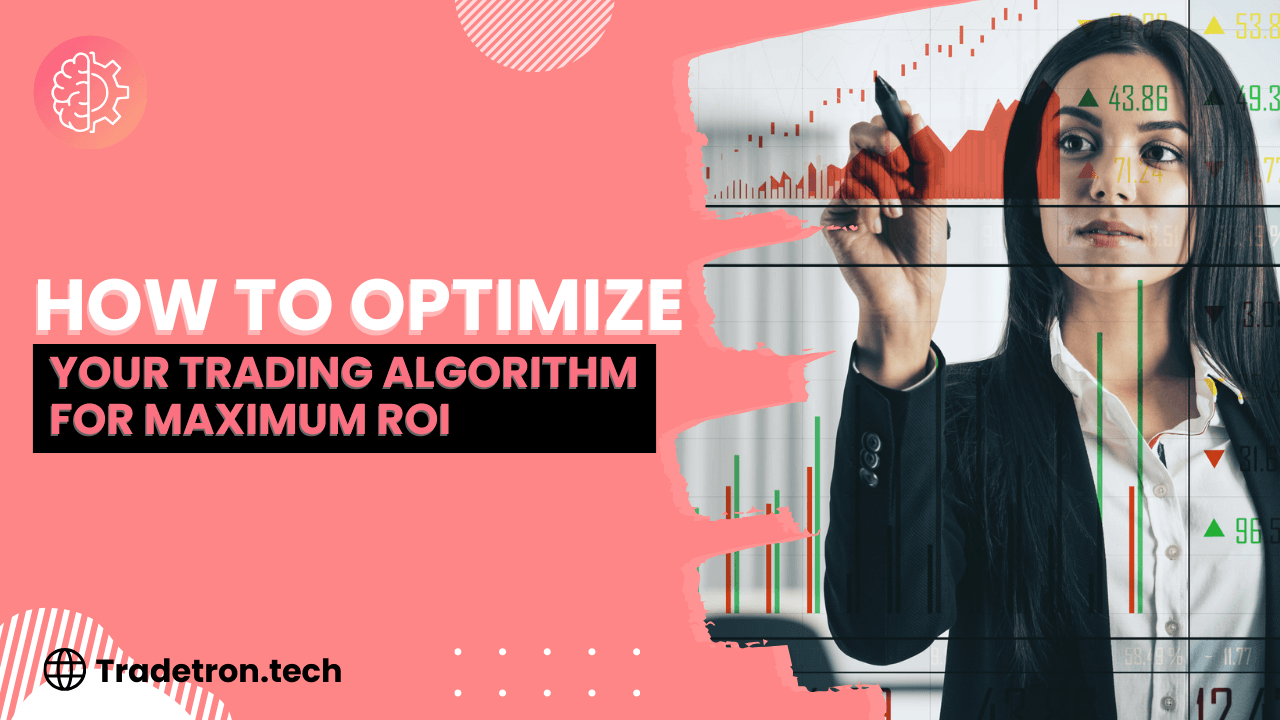
In the competitive world of algorithmic trading, the difference between average and exceptional returns often comes down to optimization. While creating a profitable trading strategy is an achievement, continuously refining that strategy to maximize Return on Investment (ROI) is what separates market leaders from the rest. Tradetron's comprehensive platform provides all the tools you need to transform a good algorithm into a great one.
Understanding Algorithm ROI Beyond Simple Returns
Before diving into optimization techniques, it's important to understand that ROI in algorithmic trading encompasses more than just percentage returns.
True ROI considers:
Net profit after transaction costs
Risk‑adjusted returns (Sharpe ratio, Sortino ratio)
Capital efficiency and utilization
Operational costs including platform fees
Opportunity cost of capital
Tradetron's performance analytics dashboard provides these metrics in an intuitive format, allowing you to focus your optimization efforts where they'll have the greatest impact.
Key Optimization Strategies for Maximum ROI
1. Parameter Optimization
Every algorithm contains parameters that influence its behavior—entry thresholds, exit conditions, lookback periods, and more. Finding optimal values for these parameters can dramatically improve performance.
How Tradetron helps:
Automated parameter sweeping to test thousands of combinations
Visualization tools to identify parameter sensitivity
Optimization goals beyond simple profit (drawdown, Sharpe ratio)
Walk‑forward optimization to prevent curve‑fitting
Instead of manually testing different parameter values, use Tradetron's optimization engine to systematically explore the parameter space and identify the combination that delivers the best risk‑adjusted returns.
2. Entry and Exit Timing Refinement
Even small improvements in entry and exit timing can significantly impact ROI. Analyzing trade execution data often reveals patterns of early entries or late exits that erode profits.
How Tradetron helps:
Trade execution analysis with millisecond precision
Visual comparison of actual vs. ideal entry/exit points
Custom execution algorithms to minimize slippage
Multi‑timeframe confirmation signals
Tradetron's trade analyzer can identify whether you're consistently entering too early in trend continuation strategies or exiting too late in reversal patterns, allowing you to fine‑tune your timing logic.
3. Market Condition Filters
Not all market environments are suitable for every strategy. Implementing filters that activate or deactivate your algorithm based on prevailing market conditions can prevent unnecessary losses during unfavorable periods.
How Tradetron helps:
Market regime classification tools
Volatility‑based filters with adaptive thresholds
Volume profile analysis
Correlation tracking across markets
Create market condition filters on Tradetron that automatically adjust your algorithm's aggressiveness based on whether the market is trending, ranging, or in a high‑volatility state.
4. Position Sizing Optimization
The way you allocate capital to each trade can have as much impact on ROI as the signal quality itself. Advanced position sizing methods can maximize returns while keeping risk under control.
How Tradetron helps:
Kelly criterion calculators
Volatility‑adjusted position sizing
Dynamic allocation based on signal strength
Comprehensive portfolio management tools
Implement Tradetron's adaptive position sizing modules that allocate more capital to higher‑confidence signals while reducing exposure during uncertain market conditions.
5. Reducing Trading Costs
Trading costs—including commissions, slippage, and market impact—can significantly erode returns, especially for high‑frequency strategies. Optimizing execution to minimize these costs directly improves ROI.
How Tradetron helps:
Smart order routing options
Time‑of‑day execution optimization
Liquidity analysis tools
Commission modeling in backtests
Use Tradetron's execution optimization tools to determine the ideal order types and timing for your specific strategy and market environment.
6. Machine Learning Enhancements
Machine learning techniques can identify patterns and relationships in market data that traditional technical analysis might miss, potentially leading to more robust signal generation.
How Tradetron helps:
Integration with popular ML libraries
Feature selection tools for identifying relevant market variables
Anomaly detection capabilities
Overfitting prevention mechanisms
Leverage Tradetron's machine learning modules to enhance your existing strategy with adaptive components that can evolve with changing market conditions.
7. Portfolio-Level Optimization
Looking beyond individual strategies, portfolio‑level optimization ensures your algorithms work together effectively, balancing risk and return across your entire trading operation.
How Tradetron helps:
Strategy correlation analysis
Automated capital allocation across strategies
Portfolio‑level risk management tools
Performance attribution analysis
Use Tradetron's portfolio optimizer to determine the ideal allocation between different strategies based on their historical performance and correlation patterns.
Implementation Process: A Step-by-Step Guide
Step 1: Establish Your Baseline
Before optimization, document your algorithm's current performance metrics using Tradetron's analytics dashboard. Key metrics should include:
Total return and annualized ROI
Maximum drawdown
Sharpe and Sortino ratios
Win rate and profit factor
Average winning and losing trade
These metrics provide the benchmark against which you'll measure your optimization efforts.
Step 2: Identify Performance Bottlenecks
Use Tradetron's performance analysis tools to identify the weakest aspects of your algorithm:
Are losses concentrated in specific market conditions?
Is slippage significantly impacting execution quality?
Are there patterns in winning vs. losing trades?
Is position sizing optimally aligned with signal strength?
The answers to these questions will guide your optimization priorities.
Step 3: Implement Targeted Improvements
Based on your analysis, select the optimization techniques most likely to address your algorithm's specific weaknesses:
For signal quality issues, focus on parameter optimization and machine learning enhancements
For execution problems, prioritize entry/exit timing and trading cost reduction
For portfolio-level concerns, implement market condition filters and improve capital allocation
Tradetron's modular design allows you to implement these improvements incrementally and measure their impact.
Step 4: Validate Through Rigorous Testing
After implementing optimizations, validate their effectiveness through:
Out-of-sample backtesting on data not used during development
Forward performance testing in a paper trading environment
Sensitivity analysis to ensure robustness across market conditions
Tradetron's comprehensive testing framework supports all these validation methods, giving you confidence in your optimizations before committing real capital.
Step 5: Monitor and Continuously Improve
Algorithm optimization is an ongoing process, not a one-time effort. Use Tradetron's monitoring tools to:
Track performance drift in real-time
Identify new optimization opportunities
Automatically adapt to changing market conditions
Deploy updates seamlessly without interrupting trading
Conclusion
Optimizing your trading algorithm for maximum ROI requires a systematic approach and powerful tools. Tradetron provides everything you need to analyze, improve, and monitor your algorithms throughout their lifecycle. By focusing on the key optimization areas outlined in this guide and leveraging Tradetron's comprehensive feature set, you can achieve the kind of sustainable, risk‑adjusted returns that define successful algorithmic trading.
Remember that optimization is an iterative process—each improvement builds on previous work, gradually transforming good algorithms into exceptional ones. Start your optimization journey today on Tradetron and unlock the full potential of your trading strategies.
Frequently Asked Questions
1: How often should I re‑optimize my trading algorithms on Tradetron?
The optimal frequency depends on your strategy and market conditions. As a general rule, conduct a comprehensive review monthly, but Tradetron's performance monitoring tools can alert you to potential issues requiring immediate attention. Strategies trading more volatile instruments or shorter timeframes typically benefit from more frequent optimization.
2: Can optimization lead to overfitting my algorithm to historical data?
Yes, this is a common risk. Tradetron addresses this through walk‑forward optimization, out‑of‑sample testing, and robustness analysis tools that help ensure your optimizations improve genuine edge rather than fitting to historical noise. Always validate optimizations across multiple market conditions before deployment.
3: Which performance metric should I prioritize when optimizing for ROI on Tradetron?
While absolute returns are important, risk‑adjusted metrics like the Sharpe ratio or Sortino ratio often make better optimization targets. Tradetron's platform allows you to create custom optimization objectives that balance returns, drawdown, consistency, and other factors according to your specific goals.
4: How do I know if my algorithm needs optimization or should be replaced entirely?
Tradetron's strategy diagnostics can help make this determination. Generally, if your algorithm still shows edge (positive expectancy) but performance has degraded, optimization is appropriate. If analysis reveals fundamental flaws in the strategy logic or complete breakdown of the market pattern it exploits, developing a new algorithm might be necessary.
5: Does Tradetron offer automated optimization for my algorithms?
Yes, Tradetron provides both guided and automated optimization tools. The platform includes automated parameter optimization, machine learning‑driven feature selection, and adaptive systems that can automatically adjust to changing market conditions. These automation features save time while still giving you full control over the optimization process and final implementation decisions.



 Made with Superblog
Made with Superblog